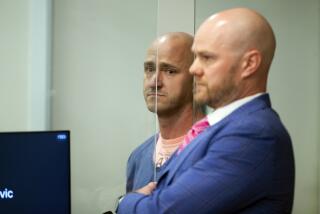Pioneer Flier Not About to Quit : Aviation: ‘I can fly in my sleep,’ says Charlie McAllister, 88. He has trained 1,500 pilots at his flying school since 1926.
- Share via
YAKIMA, Wash. — Charlie McAllister has been flying so long he has a pilot’s license signed by Orville Wright.
McAllister flies so well he’s survived a dozen emergency landings.
He knows aircraft so thoroughly that a glider he built hangs in Seattle’s Museum of Flight.
And at 88, he’s not ready to give up the throttle.
“I can fly in my sleep,” he said recently. “I’ve never had an accident of any kind flying.”
No longer able to fly legally because of his eyesight (his corrected vision is 20-40 instead of 20-20), he still goes up with employees of McAllister Flying Service.
Once in the air, he admits to putting the single-engine plane through a few moves.
As a teen-ager, he built his first plane, a glider, from blueprints published in Popular Mechanics. He still has the magazine, but not the glider, which could carry a person to a height of 15 feet.
“I broke it up because I was afraid someone would get hurt,” McAllister said.
McAllister learned to fly from legendary stunt pilot Tex Rankin of Walla Walla, Wash., in 1926. He moved to Yakima to establish his flying service, using a wrecked plane his mechanic brother had rebuilt.
“People handed us money to fly,” McAllister said in his ramshackle building at the Yakima airport.
McAllister has trained 1,500 pilots at his flying school since 1926, when Calvin Coolidge was President and George Bush was 2 years old.
It takes at least 60 days to train a licensed pilot, and landing is the tough part.
“If you stand on a fence post and jump off, that is like taking off,” he said. “Trying to jump back on the post is like landing.”
McAllister barnstormed through the Northwest, and his office still sports a weather-beaten wooden sign identifying “The Wonder Boy Pilot” and offering “Airplane Rides $1.50.”
During the Depression, he set out to capture the world endurance record of 19 hours for glider-flying. He designed and built the “Yakima Clipper,” a wood and fabric sailplane.
In June, 1933, a crowd gathered on cliffs outside Yakima to watch as McAllister was launched with a giant rubber band. He circled for nine hours. But then the wind died, and McAllister had to settle for the Northwest record.
That glider logged more than 40 flights and is on display at the Seattle museum.
The pilot’s license with Wright’s signature is kept in its original blue cloth binder, stamped by the National Aeronautic Assn. It was required for anyone attempting to set world records, McAllister said.
Wright was the chairman of the association and signed the license in 1927, but McAllister never met him.
He credits smart flying for his clean safety record, which includes a dozen safe landings after his craft’s engine quit.
Part of the reason is the flat and treeless terrain across much of eastern Washington.
During World War II, he trained mechanics to repair planes’ fabric wings.
His flying service for years has refueled the military planes that use the nearby Yakima Firing Center for training attacks. As a result his office is filled with pictures of military aviators and plaques thanking him for his contribution to this or that squadron.
He married his second wife, Georgia, at the age of 80. She helps run the business.
There has been talk of renaming the Yakima Air Terminal for McAllister, although he doesn’t expect that to happen in his lifetime.
McAllister was supposed to be the first to land at the new Yakima airport when it opened in 1926. But a fellow barnstormer named Elroy Jeppesen happened to be in the area and made a landing at 5 a.m. to claim the honor.
Jeppesen went on to fame and fortune by designing the aviation charts, known as Jepp charts, still in use by commercial airlines. The new airport terminal in Denver is to be named for him.
More to Read
Sign up for The Wild
We’ll help you find the best places to hike, bike and run, as well as the perfect silent spots for meditation and yoga.
You may occasionally receive promotional content from the Los Angeles Times.






